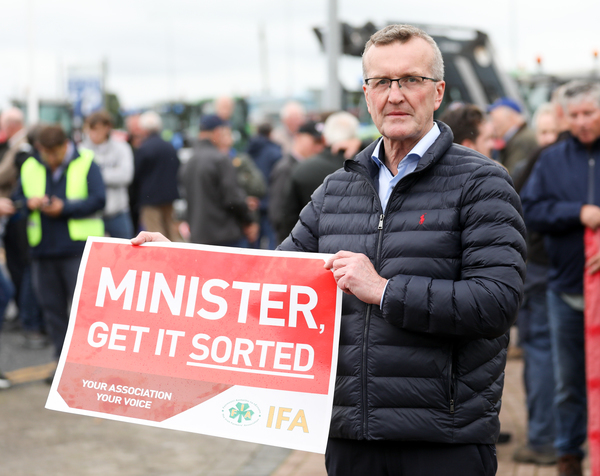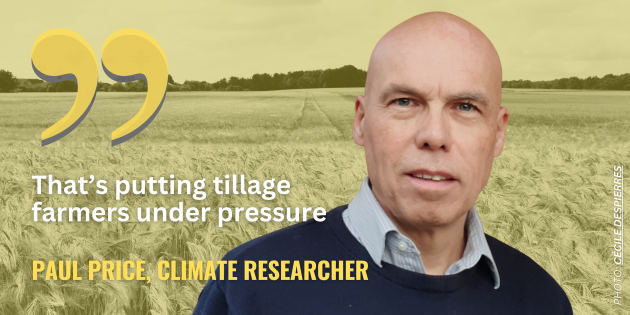
Noteworthy examines how dairy expansion has combined with years of policy neglect to leave grain growers struggling to survive.
“WE ARE, IN effect, being sacrificed.”
This is how, writing in from the cab of his tractor, one farmer summed up the sentiment felt by many tillage farmers in the room at the annual crops forum last month at the Killashee Hotel in Co Kildare.
“Why, despite lots of political talk, is [tillage] being squeezed out just so the national dairy herd can be maintained or increased,” he asked, with his comments read out to a chorus of claps and ‘hear, hear’.
This was a stinging rebuke to talks at the event about tillage’s future as a vital low-carbon cog in the Irish food system of tomorrow. Instead of holding confidence for the future, many tillage farmers feel left behind in State policy in favour of the more emissions-heavy dairy sector.
The latest conflict centres on rental costs, going through the roof in large part due to dairy expansion. As part of our AGAINST THE GRAIN investigation, we delved into the role that dairy plays in elevating these costs, and how unbridled support of the sector has pushed tillage aside and left it struggling to survive.

Rental tug of war
Dairy farmers are renting more land to spread out their herd and reduce manure on the land to comply with new nitrates derogation limits, set by the EU for our failure to address impacts on water quality.
The Irish Farmers’ Association (IFA) estimates that impacted dairy farmers will need an extra 28,000 hectares to sustain existing herd sizes and fall within the new limits.
Even before the EU’s decision hit headlines last month, the rental issue had already come to a head, according to Siobhán Walsh, who has her ear to the ground as the Irish Farmers’ Journal tillage editor.
“I speak to tillage farmers all the time who are losing land to dairy and it is now coming to a stage where these farms will no longer be viable,” she told us. Andy Doyle, the Chair of Tillage Industry Ireland, is hearing similar concerns from farmers up and down the country.
“The noise now is very definitely that there will be further pressure,” he said, with prices already soaring since last year as some dairy farmers saw the derogation writing on the wall. “Anybody could have predicted that this was going to happen. A lot of people made their move 12 months ago.”
In April, a joint report from Teagasc and the Society of Chartered Surveyors Ireland outlined how rental prices are expected to go up 14% this year. Rental rises are higher where dairy is dominant, they found.
The IFA – long a champion of dairy expansion – recently warned the Department of Agriculture that failure to address “unsustainable” land rental prices could see tillage contract substantially.
We asked the IFA if it had any concerns that its heavy support of dairy expansion may have come at the expense of other sectors, including tillage. We did not receive a response at the time of publication.
Lack of State urgency to find solutions
The rental issue is another nail in the coffin of an industry struggling with high input costs, inconsistent yields, and yo-yoing incomes. It also comes exactly as the State plans to grow the tillage area by 50,000 hectares to hit an ambitious 400,000 hectare target.
At the moment, it is difficult to see how this is going to happen, according to Clive Carter of Grain Growers Ireland that represents tillage farmers in the Midlands, South East and South.
This position is shared by leading experts. Teagasc estimates that tillage will fall to just under 250,000 hectares by 2030 – down 8% from 2022 levels. For Carter, any efforts to halt this slide will be stalled until the rental situation is addressed.
“Until recently, half of all tillage land was leased. I think that’s down to about 30% because people just aren’t able to get access [to land],” he said. “When you see land going for €500 to €600 euros an acre [0.4 hectares], it just does not stack up for the tillage farmer.”
This concern is compounded by a poor summer harvest after atrocious weather in July and August, leaving many tillage farmers facing into the red, especially those on rented ground.
Bad for tillage – bad for emissions
One of the key reasons why the State is throwing more weight behind tillage is due to its capacity to grow food at a much lower carbon footprint than livestock. As we will explain in part two of this investigation tomorrow, Irish tillage is a major supplier of animal feed, almost 40% of which goes to dairy.
Any further reduction in size will see our already high feed import bill balloon – most of it carrying a high carbon footprint. This includes soya feed from South America where deforestation is a big issue.
Any reduction in tillage in favour of more land for dairy is also bad news for our emissions, according to climate researcher Paul Price. He said it would be better to put more support into tillage as it can produce a large portion of our protein needs with less emissions.
Tillage makes up 9% of our agricultural land but accounts for just 2.5% to 4.5% of agricultural emissions, a tiny footprint compared to dairy. Price, who has led decarbonisation research projects at DCU, told us “people might be surprised” to know crops are traditionally the main protein produced on the island.
This changed around 2010, Price said, and “now milk has overtaken crops in percentage share of protein produced”. What that says is “tillage farms in dairy areas and tillage farming on dairy land has been lost to creating grass for pasture,” he added.
This was set in train as the State prepared for the end of the milk quota in 2015, pumping support into growing the dairy industry.
We are an “extreme outlier” in Europe, according to Price, as we “massively ramped up the number of cows” here while herd sizes fell across most of the EU.
“This is a very silly way to run an agri-food system,” according to Price, with methane emissions now through the roof and increasing pressure on watercourses from nitrogen run-off.
“In a balanced system, you can’t produce so much dairy,” Price said. “But in this system, it’s saying ‘oh no, produce more dairy because it’s profitable’.”
Chance to work together
There may be a win-win for dairy and tillage to work together to tackle the EU’s new rules and reduce some emissions, according to Tillage Industry Ireland’s Andy Doyle. This would see tillage farms take a portion of the manure produced on dairy farms as a form of farmyard fertiliser.
“So, having a greater amount of tillage would allow for more and better circular use of nutrients, which for the livestock sector, might help to relieve one of the biggest problems they have,” Doyle said.
Clive Carter is not so convinced, however. “I’m sceptical of taking in slurry from dairy farms… I talk to a lot of tillage farmers and they say ‘I don’t want slurry’. I’m very concerned as tillage farmers – are we solving the dairy industry’s problem?”
Many tillage farmers would prefer to see the State focus on growing tillage as a standalone industry. Otherwise, fears will grow over the sector’s long-term viability and if it can ever step out of dairy’s shadow.
“We’re aiming for 400,000 hectares. We could be losing 30,000 next year,” Carter said. “Trying to just keep things as they are is nearly a battle in itself.”


























